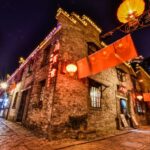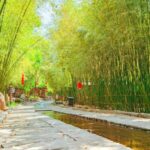Linggu Scenic Area is located on the southeast slope of Zhongshan Mountain (Purple Mountain). It is about 1.5 kilometers east of Dr. Sun Yat-sen’s Mausoleum. It is one of the three major scenic areas in Zhongshan Mountain Scenic Area. There are fewer tourists than in the other two scenic areas, Dr. Sun Yat-sen’s Mausoleum and Ming Xiaoling Mausoleum. Coupled with the ancient trees towering in the scenic area, it has the reputation of ‘deep pine in Linggu’, giving people a secluded feeling.
Historical background of the scenic area: In order to build the Ming Xiaoling Mausoleum, Zhu Yuanzhang of the Ming Dynasty relocated the famous temple of the Southern Dynasties to its current location. Later, it was destroyed in the war. It was rebuilt during the Tongzhi period of the Qing Dynasty and was on one side, no longer having its former scale. Later, a cemetery for the fallen soldiers of the National Revolutionary Army was built here. Therefore, the Linggu Temple scenic area is composed of an ancient temple and a cemetery. The central axis runs north-south for 1 kilometer and is the original site of Linggu Temple. Now the main body on the central axis is a series of buildings of the cemetery for the fallen soldiers of the National Revolutionary Army.

The main gate of the archway for the fallen soldiers of the National Revolutionary Army, the Red Mountain Gate, is opened at the southern end. Outside the gate is a large release pond, the Wanggong Pond. In summer, you can enjoy the lotus in the pond.

Entering and walking north, you will first see the archway for the fallen soldiers of the National Revolutionary Army. It has five gates and six columns, with green glazed tiles on the top and extraordinary momentum. There is a pair of stone beasts in front of the archway.

Further ahead is the unique building in the scenic area, the beamless hall. The beamless hall is the only building in Linggu Temple in the Ming Dynasty. It was built in 1381 AD. Such a large hall does not use a single beam or column and is entirely made of bricks and stones. Inside the hall is the memorial hall of the cemetery. On the middle wall is written ‘The spirit tablet of the martyrs of the National Revolution’. The surrounding walls are inlaid with ‘Lists of the fallen soldiers of the National Revolution’. Now the wax figure museum of famous people in the 1911 Revolution is also located in the beamless hall. On the southwest side outside the hall is a huge stone turtle base of the Ming Dynasty. The stone tablet on the turtle’s back is nowhere to be found.
The Linggu Tower, also known as the Memorial Tower for the Martyrs of the National Revolutionary Army, is located at the northernmost end of the central axis, standing nine stories high and serving as a landmark of the scenic area, from which visitors can enjoy a panoramic view.
To the east of the Wu Liang Hall of Linggu Temple stands the current Linggu Temple, with a square pond in front of it known as the Ba Shui. Inside the temple, there are several structures including the Mahavira Hall, the Avalokitesvara Pavilion, the Sutra Library, the Maitreya Hall, and the Ancestral Hall. The eastern courtyard of the Mahavira Hall is the Xuanzang Courtyard, where the main hall, the Da Dao Jue Hall (Xuanzang Memorial Hall), houses a mini golden pagoda containing the precious Xuanzang’s skull relics, which are usually not visible and can only be seen during special exhibitions held at Linggu Temple. Within the Linggu Temple scenic area, there are several less frequented but equally worth-visiting spots. Heading north from the ‘Linggu Song Shen’ stone tablet to the east of Linggu Temple, or traveling east from Linggu Tower, one can find the tomb of Tan Yankai, who once served as a leader of the Republic of China. The white marble peony flower bed and altar there are said to be original artifacts from the Old Summer Palace. Moving west from Linggu Tower and passing through the Wan Zhu Gui Garden, one encounters the Guilin Stone House, whose ruins are adorned with various stone carvings from the Ming and Qing dynasties, exuding an aesthetic of decay. The opening hours are from February 1st to November 30th, 06:30 to 18:30; and from December 1st to January 31st, 07:00 to 17:30. Preferential policies include free entry for children aged 6 and under or under 1.4 meters in height; half-price for children aged 6 to 18 with valid identification; free entry for seniors aged 70 and over with valid identification; half-price for seniors aged 60 to 69 with valid identification; half-price for full-time university undergraduates and below with valid identification; free entry for the severely disabled (disabled level 1 and level 2) with valid identification and one accompanying caregiver; free entry for the dependents of martyrs, military personnel who died in service, and those who died of illness with the ‘People’s Republic of China Martyr, Military Serviceman, and Sick Military Personnel Dependent Preference Certificate’; free entry for active-duty military personnel, retired military and non-commissioned officers (sergeants), and those receiving national pensions with valid identification and the ‘People’s Republic of China Veteran Preference Certificate’; free entry for firefighters with valid identification, including active, retired, disabled firefighters, fire rescue academy students, and government professional firefighters; and free entry for Buddhist clergy and their staff, as well as lay Buddhists who have undergone religious ceremonies and hold valid Buddhist certificates such as lay Buddhist certificates and conversion certificates, when entering Linggu scenic area for religious activities; free entry for individuals in Jiangsu Province who have received national awards for voluntary blood donation, voluntary hematopoietic stem cell donation, lifelong honor for voluntary blood service, and those with titles of bravery and righteousness; and free entry for Nanjing medical staff from January 2023 to December 2025, with valid work identification and residence identification for medical personnel issued by medical institutions within Nanjing’s jurisdiction, and valid proof of direct relatives to bring 1-2 direct relatives for free visits and tours. Service facilities include a parking lot: [Scenic Area Parking Lot] with a reference price of ¥7.The Linggu Scenic Area is easily accessible within 5 to 15 minutes from various locations including Taipingmen Road, Ming City Wall, Mingling Road, Meihua Valley Road, Lingyuan Road, Scenic Greenway (Ten Dynasties Cultural Garden, Boai Garden), Boai Road, Boai East Road, Post Office West Road, Post Office East Road, Linggu Temple Road, Youth Road, and Tuotuo Ridge Scenic Area, surrounded by the Purple Mountain Cableway and Astronomical Observatory Road, and the cableway lower station.
Storage: There are 2717 lockers available for luggage storage at a reference price of 10 yuan per item per day, located at the Visitor Service Center.
Guided Tours: A Route includes the entire line (Red Mountain Gate, Wu Liang Hall, No.1 Public Cemetery, Pine Wind Pavilion, Linggu Tower) with a manual guide costing 95 yuan for 60-70 minutes for groups of 30 people (inclusive) or less, and 100 yuan for groups larger than 30. The automatic guide charges 10 yuan. B Route includes Red Mountain Gate and Wu Liang Hall, with a manual guide costing 45 yuan for about 30 minutes for groups of 30 people (inclusive) or less, and 50 yuan for groups larger than 30.
Transportation within the Park: The reference price is 10 yuan per trip, and you can find it at the Xuanwu Lake Subway Station, Zhongshan Mausoleum Parking Lot, and the entrance of the Linggu Scenic Area.
Restrooms: The scenic area is equipped with multiple restrooms, which can be used according to the guide signs.
Convenience Stores: There are several convenience stores located near the entrance of the scenic area, which support WeChat and Alipay payments.









